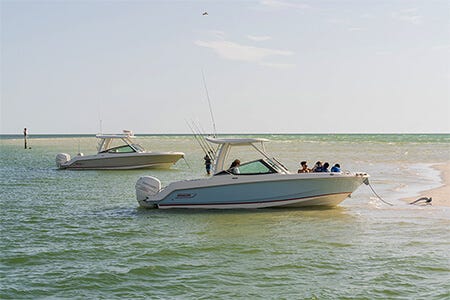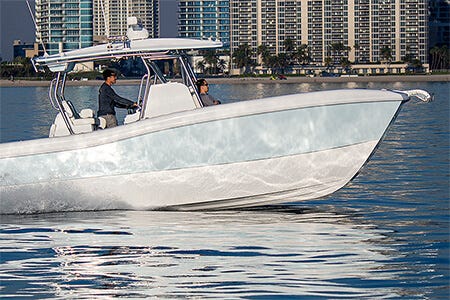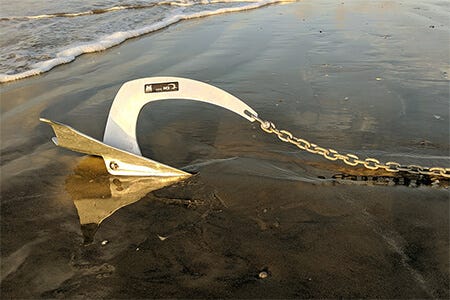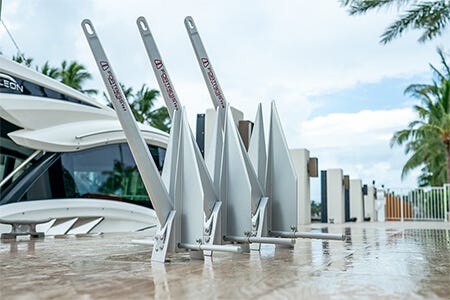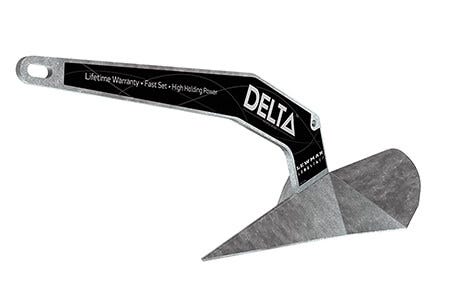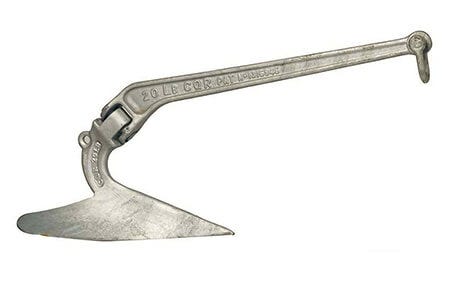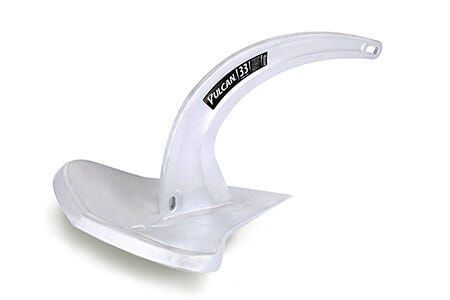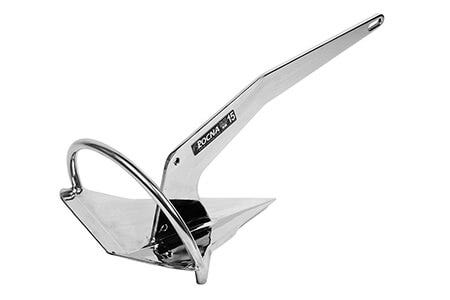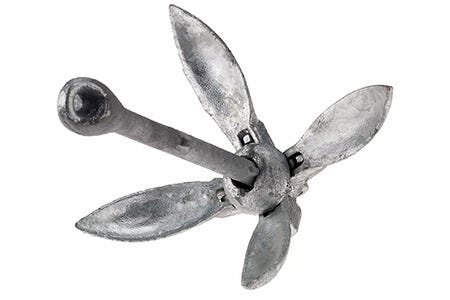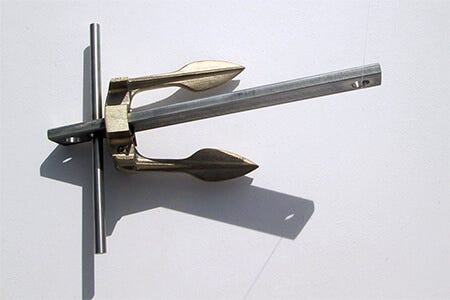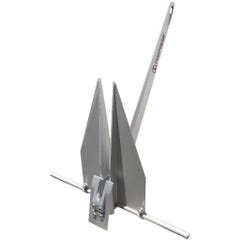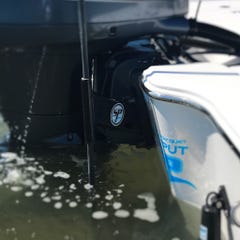Don't Drag Your Boat Anchor: How to Choose the Right Anchors
February 14, 2024 11 min read


Although you might think of it more as a convenience, your anchor is actually one of the most important pieces of safety equipment on your boat. If you lose power, your anchor is the only thing between your boat and potential destruction in the form of rocks, surf or other hazards you could be blown or swept into.
That means that even if you don’t leave your boat anchored for long periods of time or sleep aboard while anchored, choosing the right anchor is still important. Let’s look at the different styles of boat anchors commonly used today and some of their individual pros and cons.
Contents
- 1. Anchor Characteristics
- 1.1 Holding Power
- 1.2 Suitability for Different Bottom Types
- 1.3 Ability to Reset After a Wind Shift
- 1.4 Form Factor
- 1.5 Weight Relative to Holding Power
- 1.6 Cost
- 2. Boat Anchor Styles and Types
- 2.1 Fluke Anchors
- 2.2 Claw Anchors
- 2.3 Wing Anchors
- 2.4 Hinged Plow Anchors
- 2.5 New Generation Anchors
- 2.6 Grapnel Anchors
- 2.7 Mushroom Anchors
- 2.8 Navy Anchors
Anchor Characteristics
Anchors only have one simple job: keeping boats from drifting. So how many factors can there really be in choosing the best boat anchor? Well, you’d be surprised. To begin with, an anchor’s ability to keep your boat where you want it — referred to as its holding power — varies widely depending on the kind of bottom you’re anchoring in.
So the anchor style that will hold your boat best on a muddy bottom likely isn’t the same one that will hold your boat best on a grassy bottom. Even beyond that, there are quite a few factors to consider when choosing the best anchor for your boat. Here’s what you need to consider:
Holding Power
Obviously, the single most important factor in your choice of anchor is whether it can effectively hold your boat. If an anchor can’t reliably keep your boat in place under any conditions you can reasonably expect to encounter — including wind, current, waves, bottom type and water depth — then none of the other following factors matter at all.
If an anchor can’t reliably keep your boat in place under any conditions you can reasonably expect to encounter, then none of the other following factors matter at all.
Most anchor manufacturers publish recommendations for matching anchor size to boat size. Always err on the side of caution; a size too big is better than a size too small.
Suitability for Different Bottom Types
Almost all anchor styles work well on a sand bottom. Beyond that, there’s quite a bit of variation.
Some styles work well in soft mud, where others struggle.
Some are designed to hold on rocky bottoms but aren’t much good elsewhere
Most struggle on grassy bottoms, but some do much better than others. In choosing a boat anchor, it’s important to factor in the type of bottom(s) you anchor on most frequently.
Ability to Reset After a Wind Shift
It’s not the weight of a boat anchor that holds your boat in place; rather, it’s the ability of the anchor to partially bury in the bottom, known as “setting.” But when the wind and/or current shift, changing the direction of pull, the anchor can be dislodged from the bottom.
Some anchor styles are better than others at resetting themselves rather than simply dragging across the bottom. If you plan to spend the night on your anchored boat or leave your boat unattended while anchored, an anchor’s ability to reset is important.
Form Factor
For owners of smaller boats, the size and shape of an anchor are another important factor. After all, if you can’t fit that new anchor into your anchor locker, it isn’t going to do you a lot of good. Some anchor styles are awkwardly shaped and take up a lot more physical volume for a given holding power than others.
Some anchor styles are awkwardly shaped and take up a lot more physical volume for a given holding power than others.
If your anchor stays on a bow roller or pulpit, most styles of anchor will work well. But if you store your anchor in a compartment, you may need to look for an anchor that’s relatively flat and/or compact.
Weight Relative to Holding Power
The weight of an anchor isn’t directly related to its holding power. An anchor of one style that’s suitable for a 30’ powerboat might weigh twice as much as an anchor of a different style that can hold the same boat. If you’ve got a big boat and a windlass or winch, that’s not a big deal. But if you pull your anchor by hand and/or have a smaller boat that’s sensitive to weight distribution, anchor weight is an important consideration.
Cost
Some boat anchors cost considerably more than others that deliver similar performance. If you’re on a budget, it’s worth shopping around.
On the other hand, an anchor is among the most important pieces of safety equipment on your boat.
Cheap anchors are cheap for a reason: they’re made with inferior materials and lower standards.
Choosing a less expensive style of anchor that will still meet your needs is reasonable, but buying a cheap knockoff of the same style isn’t. Cheap anchors are cheap for a reason: they’re made with inferior materials and lower standards.
Boat Anchor Styles and Types
Over the centuries, there have been many thousands of different anchor designs, ranging from a rock with a rope tied around it to experimental contraptions that look more like modern art than boating equipment. Today, though, most recreational boat anchors fall into one of several proven design categories, each with its own strengths and weaknesses
Which one is best for you depends on your unique situation — the size of your boat, the type of bottom you anchor in most frequently, the amount of wind and current you typically deal with, how long your plan to leave your boat anchored, your anchor storage options and, of course, your budget.
Fluke Anchors
Fluke anchors — also commonly called Danforth anchors — are the most widely used on smaller recreational boats for several good reasons: They’re versatile, fairly lightweight relative to their holding power, and easy to store since they fold mostly flat. They work best on bottoms of sand, mud or clay but don’t set or hold well on grassy bottoms. On rocky bottoms, fluke anchors have a tendency to get stuck.
Note that there’s a good bit of variation among fluke anchors. The angle between the flukes and shank is very important to a fluke anchor’s ability to set and hold. The optimal angle is 32˚. A variation of even a few degrees affects performance, so precision manufacturing and good quality control are important. Cheap fluke anchors with short shanks and slip ring attachment points can be difficult to set and don’t hold as well as higher quality fluke anchors.
Aluminum fluke anchors like those manufactured by Fortress are significantly lighter weight than steel anchors of equivalent size and yet deliver superior holding power in tests. They can also be easily disassembled with a wrench and screwdriver for storage. You wouldn’t want to disassemble your primary anchor, but this can be helpful for a larger “storm anchor” that is reserved for extreme conditions. Finally, the fluke angle of a Fortress anchor can be changed from 32˚ to 45˚ for significantly better holding power in soft mud.
Claw Anchors
Also commonly called Bruce anchors, these one-piece anchors are a great all-around choice that sets and resets easily.
Claw anchors perform well on most types of bottom except grass and hard clay and deliver better performance in rock and coral than any other general-purpose anchor.
On the downside, claw anchors generally need to be heavier than other styles to deliver equivalent performance. This, combined with their unusual form factor, makes them a poor choice for smaller boats without a bow anchor roller or windlass. Special anchor rollers designed specifically to accommodate claw anchors aren’t strictly required but are strongly recommended.
Wing Anchors
Another one-piece boat anchor design, the wing anchor is also referred to as a plow anchor and a Delta anchor. Wing anchors look almost the same as hinged plow/CQR anchors except that they lack the hinge in the shank. They are very popular on mid-sized recreational powerboats with bow rollers, where they fit comfortably and, thanks to their shank profile, “self launch” without having to be helped over the end of the roller.
Wing anchors deliver exceptional holding performance relative to their weight, making them a good choice for small boats and hand-pulling.
Delta-style boat anchors deliver exceptional holding performance relative to their weight in most bottom types. That makes them a good choice for small boats and hand-pulling, although they can be difficult to fit in lockers meant for fluke style anchors. Their single, sharp point with added lead “ballast” helps them penetrate weedy, grassy and hard clay bottoms better than most other anchors. Like fluke anchors, they foul more easily in rock and coral than claw anchors. They also don’t reset themselves as well as hinged plow anchors.
Hinged Plow Anchors
Hinged plow anchors — also known as CQR anchors — are similar to wing anchors but have a hinged shank. The hinge helps the anchor remain set as the boat swings in shifting winds and currents. On the other hand, the hinged plow design is more difficult to set than the unhinged wing design and has significantly less holding power, pound-for-pound.
That makes hinged plow anchors best suited for larger cruising yachts that can easily accommodate heavy, large anchors and that often anchor for long periods of time where the ability of an anchor to withstand changing directions of pull is important. Like wing anchors, hinged plow anchors don’t hold as well in mud as fluke anchors and can get hung up in rocks more easily than claw anchors. Hinged plow anchors are also relatively expensive.
New Generation Anchors
A whole slew of newer boat anchor designs share the same basic shovel or spade-like shape and are also referred to as scoop anchors. They include anchors made by Mantus, Rocna, Spade, Manson and a number of other companies.
Virtually all of them outperform earlier designs like wing and plow anchors in most or all categories.
They have few downsides except that they’re more difficult to stow than fluke anchors and, generally speaking, are significantly more expensive than other anchors.
New generation anchors have few downsides except that they’re more difficult to stow than fluke anchors and, generally speaking, significantly more expensive than other anchors.
All new generation anchors feature a single fluke that’s shaped basically like a sharply pointed shovel blade.
Some employ a semi-circular “roll bar” to keep them upright on the seafloor.
Others use ballast — extra weight — in the point to stay upright.
Anchors without roll bars tend to fit better on bow rollers and are more aesthetically appealing. Roll bars, on the other hand, are generally considered more effective than ballasted tips when it comes to setting and resetting the anchor.
Small mushroom anchors are okay for holding lightweight boats in place for a short period of time in calm conditions, but not for much else.
Grapnel Anchors
Grapnel anchors are basically grappling hooks designed to snag on rocks, reefs, logs or other bottom structure, rather than burying themselves in sediment. There are two primary types: small folding grapnel anchors and larger fixed grapnel anchors. Folding grapnel anchors are fine for very small craft like canoes, rowboats and jon boats and tend to work better in moving water than mushroom anchors.
Fixed grapnel anchors — commonly called reef anchors or wreck anchors — feature fixed “tines” that are designed to straighten out under load so the anchor can be pulled free if necessary. Grapnel anchors have virtually zero holding power on sand or mud bottoms and shouldn’t be used as primary anchors.
Mushroom Anchors
Mushroom anchors are very effective if they can be left in place for an extended period of time to slowly bury in the bottom. For this reason, larger mushroom anchors are widely used to secure mooring balls. The smaller mushroom anchors commonly found on small craft, on the other hand, depend almost entirely on their weight to hold a boat in place.
The only kind of bottom they can get any purchase on is soft mud. They’re okay for holding lightweight boats in place for a short period of time in calm conditions, but not for much else.
Navy and Sea Claw Anchors
In the recreational boating world, the term “Navy anchor” usually refers to a small version of the massive anchors you see attached near the bow of a warship.
They are similar to fluke anchors in that the flukes “swivel” back and forth at the end of the shank.
Rather than thin, triangular flukes, though, Navy anchors use thicker willow leaf-shaped flukes. This makes them much heavier than fluke anchors in relation to their physical size. Most are vinyl-coated and intended for use on paddlecraft, rowboats, and very small sail and powerboats.
Rather than thin, triangular flukes, Navy anchors use thicker willow leaf-shaped flukes, making them much heavier for their size than fluke anchors.
A variation on the Navy anchor, commonly known by the brand name Sea Claw, has found favor with inshore saltwater fisherman, since its work better without chain than most alternatives. Danforth-type fluke anchors virtually require a length of chain to function correctly, but the Sea Claw, with its heavy, bronze flukes, works at least reasonably well with no chain at all, making it a stealthier option for inshore anglers.

